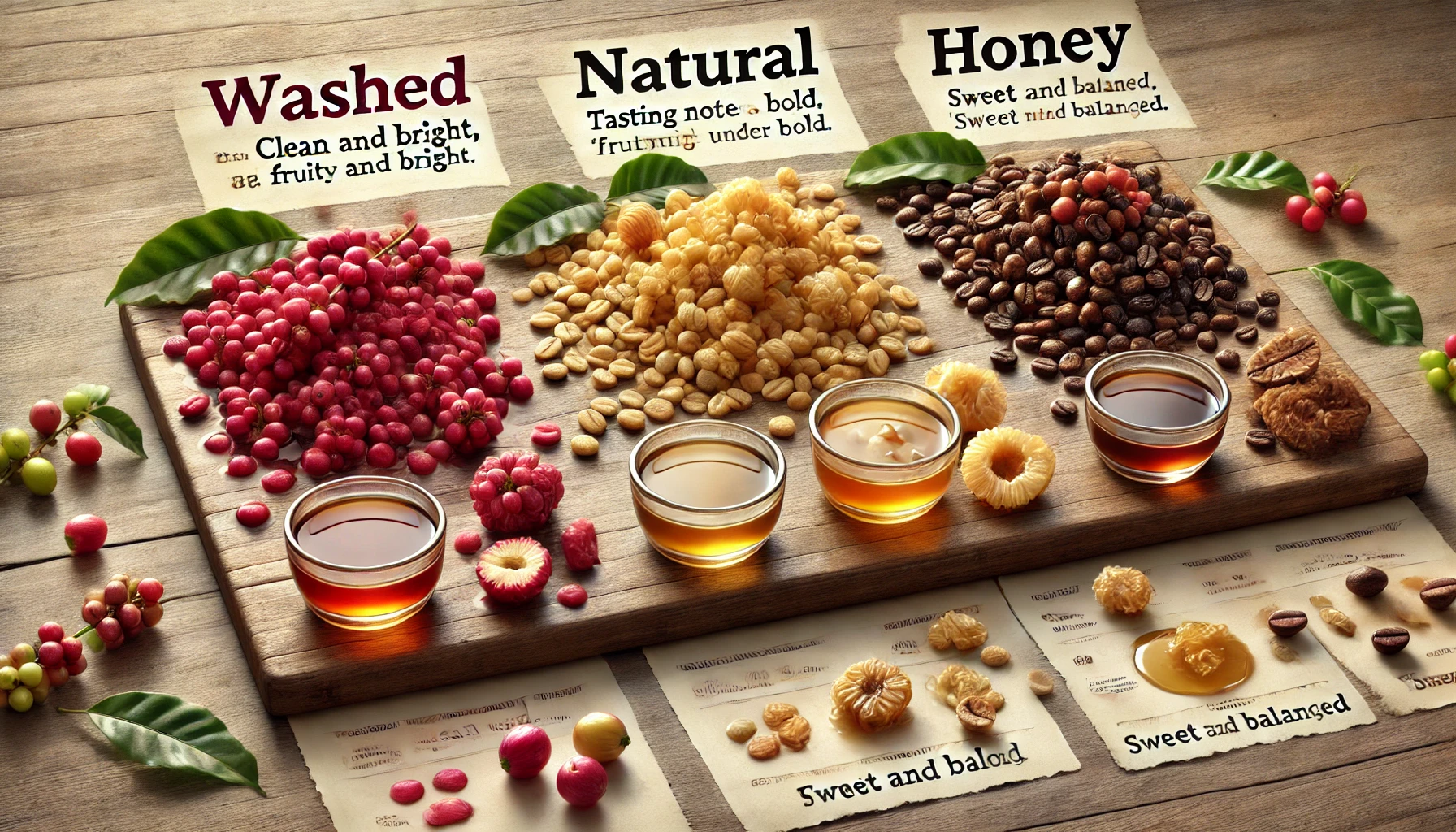Before your coffee reaches your cup, it goes through a crucial step known as processing — the method used to remove the coffee bean from its cherry. This step plays a huge role in how your coffee will taste. In fact, the same bean processed in two different ways can result in two entirely different flavor experiences.
The three most common processing methods are washed (wet), natural (dry), and honey. Let’s break down how each one works, what it tastes like, and which one might be your perfect match.
Washed (Wet) Process
The washed process is the most widely used method in specialty coffee. It involves removing all the fruit from the coffee seed (bean) before it’s dried.
How It Works:
- Cherries are picked and sorted for ripeness.
- Beans are removed from the pulp using a pulping machine.
- The beans are fermented in water tanks to remove the sticky mucilage layer.
- After fermentation, they’re washed again and then dried — either on raised beds or patios.
Flavor Profile:
- Clean, crisp, and bright
- Higher acidity
- More clarity in flavor
- Highlights the origin’s unique characteristics
Common Origins:
- Ethiopia (washed Sidamo or Yirgacheffe)
- Colombia
- Kenya
- Guatemala
Best For:
- People who enjoy complex, tea-like or citrusy coffees
- Pour-over and other filter methods
Washed coffees are celebrated for their transparency, meaning the natural qualities of the bean and terroir shine through.
Natural (Dry) Process
The natural process is the oldest method of processing coffee and is often used in regions where water is scarce.
How It Works:
- Coffee cherries are picked and left whole to dry in the sun, usually on raised beds or patios.
- The drying process can take 2 to 4 weeks, during which the cherries are regularly turned to avoid mold.
- Once dried, the fruit is removed from the bean using a hulling machine.
Flavor Profile:
- Fruity, bold, and full-bodied
- Lower acidity but more sweetness
- Notes of blueberry, strawberry, wine, or tropical fruits
Common Origins:
- Ethiopia (natural process Harrar or Guji)
- Brazil
- Yemen
Best For:
- Those who enjoy sweet, intense, and unconventional flavors
- Cold brew, French press, and espresso lovers
Natural coffees often have a heavier mouthfeel and fruit-forward taste that stands out in blind tastings.
Honey Process (Pulped Natural)
The honey process is a middle ground between washed and natural. Despite the name, no honey is involved — the term comes from the sticky, sugary mucilage that remains on the bean during drying.
How It Works:
- The outer skin is removed, but the mucilage layer is left on the bean.
- Beans are then dried with this layer still intact, often on raised beds.
- The amount of mucilage left and drying conditions affect the final flavor.
There are variations:
- Yellow Honey: Minimal mucilage, dried quickly, cleaner cup
- Red Honey: More mucilage, slower drying, richer sweetness
- Black Honey: Most mucilage, slowest drying, most intense
Flavor Profile:
- Sweet and balanced
- Moderate acidity
- Notes of red fruit, caramel, and floral tones
Common Origins:
- Costa Rica
- El Salvador
- Nicaragua
- Panama
Best For:
- Coffee drinkers who like a balance of clarity and sweetness
- Great for espresso, pour-over, and batch brew
Honey-processed coffees often have the body of a natural with the clean finish of a washed — a perfect hybrid for many.
Which Processing Method Is Best?
It depends on your taste preference:
| You Like… | Try This Method |
|---|---|
| Bright, clean, citrusy coffee | Washed |
| Sweet, fruity, bold flavors | Natural |
| Balanced, juicy, sweet coffees | Honey (pulped natural) |
If you’re exploring new coffees, look at the label — many specialty bags now indicate the processing method, and it’s a great way to guide your discovery.
Final Sip: Processing Shapes the Cup
Processing is one of the most important — and often overlooked — stages in the journey from cherry to cup. It influences not just how coffee tastes, but how it smells, feels, and even brews.
Next time you enjoy a cup, consider how it was processed. Whether it’s a washed Ethiopian with floral clarity or a natural Brazilian bursting with berry sweetness, there’s a world of flavor behind the method.

